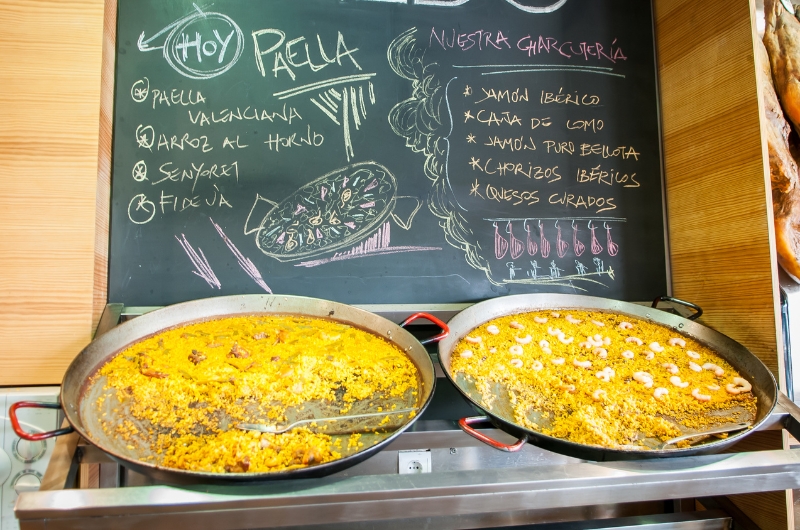Paella Valenciana is typically enjoyed at lunchtime, aligning with the Spanish tradition of having the largest meal of the day, in the afternoon.
When it comes to Spanish cuisine, nothing captures the essence of Valencia quite like paella. This iconic dish, known for its vibrant saffron hue and rich, hearty flavors, is more than just a meal—it’s a cultural symbol, steeped in history and tradition. Join us on a culinary journey to uncover the origins, traditions, and best places to savor this beloved Spanish delicacy.
History of Paella
Paella’s story begins in the mid-19th century in the Albufera region, near Valencia. Originally a humble farmer’s dish, it was a midday meal prepared by field workers using ingredients readily available in the countryside. The earliest version, paella Valenciana, combined rabbit, chicken, snails, and a variety of beans, all cooked over an open fire in a wide, shallow pan known as a “paellera.”
Traditions and Customs
The preparation of paella is as much about the process as it is about the ingredients. Traditionally, it’s cooked outdoors over a wood fire, infusing the dish with a unique, smoky flavor. The act of making paella is often a communal event, bringing together family and friends, especially on Sundays. In Valencia, it’s not just a meal—it’s a celebration of togetherness and tradition.
Birthplace of Paella
The Albufera region’s fertile lands are perfect for growing the short-grain rice essential to paella. This area, rich in history and natural beauty, is considered the birthplace of this iconic dish. The traditional methods of rice cultivation and cooking have been passed down through generations, preserving the authenticity of paella.
When to Eat Paella
Paella is typically enjoyed at lunchtime, aligning with the Spanish tradition of having the largest meal of the day in the afternoon. It’s a hearty dish, best savored in the company of good friends and family. In Valencia, Sundays are synonymous with paella, a tradition that many locals hold dear.
Best Places to Eat Paella
For the best paella experience, there’s no place like Valencia. The city is dotted with numerous renowned restaurants. La Pepica, a beachfront restaurant, has been serving delicious paella since 1898 and was a favorite of Ernest Hemingway. Casa Carmela, known for its traditional wood-fired paellas, and L’Estimat, famous for its seafood paella, are also top choices.
Interesting Facts About Paella
- World Records: Valencia holds the record for the largest paella ever made, which served an astonishing 110,000 people in 2001.
- Paella Competitions: The Sueca International Paella Contest, held annually, attracts chefs from around the world to compete in crafting the perfect paella.
- Cultural Impact: Paella is not just a dish but a cultural ambassador, representing the rich culinary heritage of Valencia globally.
Paella is more than just food; it’s a symbol of Valencian culture and tradition. From its humble beginnings in the Albufera region to its status as a globally celebrated dish, paella brings people together, creating memories and delighting palates. Whether you’re savoring it in a traditional Valencian restaurant or trying your hand at making it at home, paella is sure to leave a lasting impression.
History of Paella Valenciana:
- Origins: Paella originated in the Valencia region of Spain in the mid-19th century. It was initially a farmer’s or laborer’s meal, cooked over an open fire.
- Evolution: The original paella, known as “paella Valenciana,” included ingredients like rabbit, chicken, snails, and beans. Seafood paella developed later as a coastal variation.
Traditions and Customs:
- Preparation: Traditionally, paella is cooked in a wide, shallow pan called a “paellera.”
- Social Aspect: It’s often prepared during family gatherings and festivals, symbolizing community and celebration.
- Sunday Tradition: In Valencia, Sunday is the traditional day to enjoy paella with family.
Birthplace:
- Albufera Region: The Albufera region near Valencia is considered the birthplace of paella, due to its ideal rice-growing conditions.
When to Eat Paella:
- Lunchtime Meal: Paella is typically eaten during lunchtime, as it’s a heavy dish. Evening consumption is less common.
Best Places to Eat Paella:
- Valencia: Some of the best paella can be found in Valencia, particularly in areas like El Palmar and along the beachfront.
- Famous Restaurants: Restaurants such as La Pepica, Casa Carmela, and L’Estimat are renowned for their paella.
Interesting Facts:
- World Records: The largest paella ever made was in Valencia in 2001, serving around 110,000 people.
- Paella Competitions: There are numerous paella cooking competitions, the most famous being the Sueca International Paella Contest.
